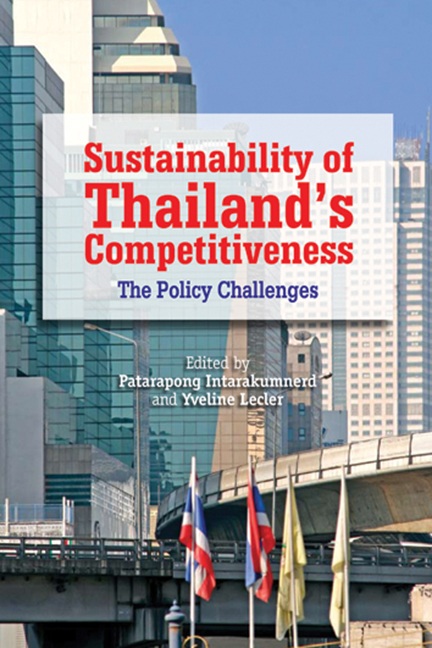Book contents
- Frontmatter
- Contents
- Preface
- Abbreviations
- Contributors
- Introduction
- Part I Thailand's Industrial Development: General Views
- Part II The Roles of Institutions: Clusters and Industrial Estates
- Part III Firms and Government New Initiatives: The Industry Analysis
- 6 Manufacturing and Management Systems of Japanese Manufacturers in Southeast Asia: The Case of Automobile Industry in Thailand
- 7 The Textile and Garment Industry in Thailand: The Technology and Education Upgrading Challenge
- 8 From Growth Based on Low Cost to Capability Upgrading Policies: The Thai Hard Disk Drive Industry
- Index
8 - From Growth Based on Low Cost to Capability Upgrading Policies: The Thai Hard Disk Drive Industry
from Part III - Firms and Government New Initiatives: The Industry Analysis
Published online by Cambridge University Press: 21 October 2015
- Frontmatter
- Contents
- Preface
- Abbreviations
- Contributors
- Introduction
- Part I Thailand's Industrial Development: General Views
- Part II The Roles of Institutions: Clusters and Industrial Estates
- Part III Firms and Government New Initiatives: The Industry Analysis
- 6 Manufacturing and Management Systems of Japanese Manufacturers in Southeast Asia: The Case of Automobile Industry in Thailand
- 7 The Textile and Garment Industry in Thailand: The Technology and Education Upgrading Challenge
- 8 From Growth Based on Low Cost to Capability Upgrading Policies: The Thai Hard Disk Drive Industry
- Index
Summary
As previous chapters have shown, Thailand has to upgrade its capabilities in various areas to make its industrial development sustainable for the future. The hard disk drive (HDD) industry, which is a high tech industry, is a good example for illustrating the challenges the country is now facing to keep or improve its position in the global value chain.
It started in Thailand in the early 1980s as a spinoff from Singapore, and developed continuously during the past two decades, making the country the top world producer and exporter in 2005–06. This apparent success story, is however, hiding weaknesses that might put the industry's future growth in danger. Indeed, the Thai HDD industry's past and further development cannot be isolated from the regional agglomerations that took place over time in various countries, nor from the network implemented by foreign HDD assemblers and major global suppliers. It cannot be evaluated either without taking into account a broad variety of national factors, including public policies, education and manpower training, technology upgrading resources, etc., that gave the country some comparative advantage over its Asian neighbours. But while this is eroding today, these factors also constitute new challenges for the future.
The HDD which is one of the major segments of the electric and electronic (EE) industries accounts for a significant part of the whole exports of the country and, although this has not always been the case, it is now one of the industries benefiting from government attention.
After presenting Thailand's past and present positions in the industry's global and regional division of labour (section 1), the chapter will address the issue of the sustainability of the industry in the future, focusing on the policies implemented to take up the new challenges and remain attractive (section 2). It will finally introduce the HDD cluster programme which appears to be the most achieved initiative to address altogether the different challenges the Thai HDD industry has to face to remain globally competitive (section 3).
- Type
- Chapter
- Information
- Sustainability of Thailand's CompetitivenessThe Policy Challenges, pp. 274 - 318Publisher: ISEAS–Yusof Ishak InstitutePrint publication year: 2010

